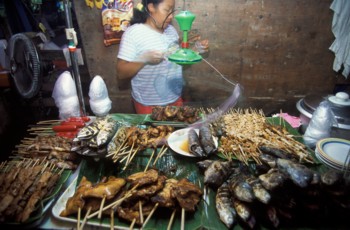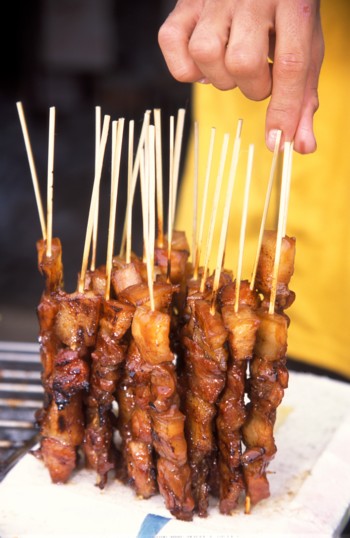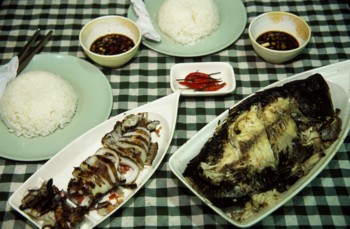Story and Photos by Victor Paul Borg
–Grilled Garlic Fish
–Lemon and Soy Barbecued Chicken
–Pork Adobo
–Tortang Talong (Eggplant Fritters)
–Pritong Talong (Grilled Eggplants in
Vinegar and Spices)

Even among the sophisticated urbanites in Manila, ihaw ihaw is the taste of home, something like comfort food. Street-side barbecues selling grilled meats and fish with rice appear at almost every street corner in the Philippines every afternoon at dusk; many restaurants have a section on their menu dedicated solely to grills (many restaurants in fact add “grill” somewhere in the name of the establishment, specifying that it is a “Grill & Restaurant”). And in the heart of Manila, it is the ihaw ihaw joints that are open round the clock, not the fast food chains. Once, for example, I was with an environmentalist who’s pedantic about health issues, and she stopped to buy some skewers of grilled pork. “This is not really good for health,” she muttered. “It’s fatty, and harmful chemicals from the charcoal get into the meat. But I can’t resist it.”
Despite my friend’s fussiness, grills in the Philippines have the health advantage of being fresh and cooked plainly–something that allows the simple tastes of grilled meats and fish to pervade. If you don’t fancy starting a charcoal barbecue, meats and fishes can be grilled with good results on gas grills, although of course the taste over coals is superior. Filipinos eat grills with plain steamed rice accompanied with home-made barbecue sauces that they drizzle on the rice and meat according to personal preference. Sometimes, one or two other dishes, including soups eaten with rice, are served to make the meal less dry.

In the more elaborate grilled meats, the meat is marinated. The most popular marinade is made up of equal quantities of tomato ketchup and vegetable oil (enough of these two to cover all of the meat), a finely chopped onion, crushed garlic (a little, just enough for the flavor from the garlic to blend into the overall taste, but not enough to be a distinct taste), chopped red chillies (enough for a spicy tang), and some sugar (not more than a tablespoon). Another variation of this marinade–made by those who are more health-conscious, such as cooks in upmarket restaurants–eliminates the oil and introduces Sprite (the soft drink): it consists of tomato ketchup, lime juice, Sprite, soy sauce (in a respective ratio of 5:3:3:2) and a bit of crushed garlic. A different marinade is made of vinegar (enough to cover the meat), pepper, salt, a little crushed garlic, juice from half a lime (or lemon), and a finely chopped onion. In all cases, the preparation is the same: pieces of pork or chicken are marinated for about an hour, then attached to skewers and grilled; while grilling, more marinade is brushed on the meat. Then the marinade is reserved to be served with the meal as a homemade barbecue sauce. To prepare this sauce, a drizzle of soy sauce is added to the marinade, and then served on the table to be spooned onto the rice individually, according to personal taste.
Sometimes preparations of grilled meats are cooked in two processes. Pieces of meat are first cooked adobo style–in equal quantities of soy sauce and white vinegar, two bay leaves, two cloves garlic chopped, a small onion, chopped, and one long hot green pepper–until half-cooked, then drained and grilled until cooked. This process is mostly applied to, and works best with, pork liver or chicken liver. In this cooking method, the onion and garlic are fried in a little oil until onion is soft, then the rest of the ingredients are added, brought to boil, and simmered for a minute or two. Then, the liver or meat is taken out, stuck into skewers, and grilled for another minute.
All types of grills are invariably served with plain steamed rice and home-made barbecue sauces or condiments (called sawsawan) that are drizzled on the rice by each person according to preference. Two of these condiments–the ones that are initially used to marinate the meats–are explained above. A more common sauce consists of soy sauce (ten tablespoons), lemon (one-and-a-half tablespoons), a heaping tablespoon of chopped onion, and two chopped red chillies. A simpler sauce is made with a half a cup white vinegar, two cloves of crushed garlic, and a small onion finely chopped. Another two condiments are chilli sauces. The easiest to make consists of half a cup of fish sauce, a tablespoon of red chilli flakes, and the juice of one squeezed lime. A more elaborate chilli sauce is sometimes served, cooked in advance and kept in jars. To make enough of this chilli sauce for several servings, boil seven ounces of chopped red chillies in a cup of water with two tablespoons of sugar, one tablespoon salt, and one tablespoon vinegar. When it starts to boil, reduce the heat, simmer for fifteen minutes, and then blend the contents to a puree. In a separate pan, put two tablespoons of vegetable oil, pour in the chilli puree, and cook on a low heat. As the puree bubbles, stir constantly to avoid the puree sticking to the bottom, cooking for about five minutes. This chilli sauce–which is very hot–can then be stored in an airtight jar in the fridge and dollops of it served on the table as needed; take care to use only clean spoons in the chilli sauce to avoid mold setting in.

Unusual Grills
Filipinos have developed a taste for all kinds of stomach-churning grills. One of the most popular grills is called Sisig–it consists of the chopped pieces of different parts of pork, particularly the ears, fat, intestines, and stomach stuck on a skewer and grilled in the same way pieces of lean pork is grilled, either plainly or basted with marinade. Intestines are additionally eaten independently in another incarnation. Pieces of Pork Intestines stuck on skewers and grilled plainly. Pork Fat, meanwhile, consisting of cubes of plain fat from pigs’ skin skewered and grilled, is commonly eaten as a snack with beer–the fat crackling in my mouth made me queasy when I ate this once. The most famous unusual parts of chicken that are eaten are skewered Chickens’ Asses–literally, pieces of meat carved from the ass of the chicken, and plainly grilled. These are chewy (the fat) and crunchy (the cartilage) when eaten. Inihaw na Balun-balunan (chicken gizzard) is also popular, chopped and skewered and grilled, and very chewy. Adidas (grilled chicken feet) are also chewy and utterly incapable of satiating a hungry stomach–it’s all titbits of fatty skin attached to bone. Yet, perhaps the most potentially repulsive, at least for Western tastes, of grilled meats are found in small poor villages in rural areas: snakes grilled whole, and, on a more intense level, monitor lizards (there are six feet-long lizards, thick as an arm) which are skinned and grilled.

In a bowl, combine the garlic, coconut vinegar, chilli, and salt and pepper and mix well. Reserve some of the marinade for basting. Place the fish fillets in a shallow bowl and pour the marinade over them. Marinate for 30 minutes.
Brush the grill with vegetable oil and grill the fillets over medium-hot flames for 4 to 5 minutes, turning once. Remove from the grill, top with the reserved marinade, and serve immediately.

Filipinos love grilled chicken, and here is an interesting twist on it. Serve with any of the hot sauces described above. Note: This recipe requires advance preparation.
Combine the lemon juice, soy sauce, garlic, vegetable oil, hot sauce, and sugar in a bowl and mix well. Place the chicken breasts in a large square baking dish and pour some of the marinade over them, reserving some marinade for basting. Cover the dish with plastic wrap and refrigerate overnight.
Remove the chicken from the refrigerator and allow to reach room temperature. Grill the breasts over hot coals for 10 to 12 minutes, turning them often and basting them with the reserved marinade. Remove from the heat and serve with rice and an Asian hot sauce as described above.
Any kind of meat or fish, including squid, can be substituted for the pork in this dish. Potatoes can be added with the onions–one medium potato, chopped in 1/2-inch cubes.
2 tablespoons vegetable oil
2 cloves garlic, chopped
In a frying pan, heat the oil and fry the garlic and onions over medium heat until the onion is soft. Add the pork and fry for a minute, stirring. Add the soy sauce, vinegar, water, sugar, bell pepper, bay leaves, and chilli. Bring to boil, reduce heat and simmer for about 30 minutes, until the pork is tenderly cooked.
Tortang Talong (Eggplant Fritters)
The narrow Asian or Middle Eastern eggplants work best using this method of first cooking them on open fire in the two recipes below. If you can’t get hold of these narrow eggplants, use normal eggplants and split them in half while cooking over the fire, but make sure they are still attached at the stem for easy handling.
Over a medium fire on a grill, cook the eggplant, turning it frequently so each part of it is exposed evenly to the fire, until the skin is charred and the eggplant is soft. Let cool slightly, then peel off the skin. With a fork, flatten the eggplant so you’re left with two flattened fritters of eggplant with the stem still attached.
Meanwhile, in a bowl or deep plate, beat the egg and mix in all the other ingredients except the vegetable oil. Dip the eggplant sections in the egg mixture, then fry in a frying pan with the oil on low-medium heat. Flip over, so that each begins to get brown, a few minutes on each side. Cut each fritter in half before serving.
Pritong Talong (Grilled Eggplants in Vinegar and Spices)
As in the dish above, split the Western eggplant in half lengthwise if that’s what you’re using, or leave whole if you are using the slim eggplants.
Over a medium fire on a grill, cook the eggplant, turning it around regularly so each part of it is exposed evenly to the fire, until the skin is charred and the eggplant is soft. Let cool slightly, then peel off the skin. Roughly chop the eggplant, then mix it with the rest of the ingredients in a bowl, and serve.





